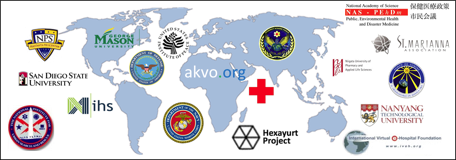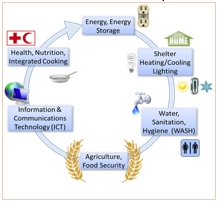

Two active, complementary efforts: STAR-TIDES and Collaborative Community Resilience (CCR) help build individual and community resilience to natural and man-made emergencies while increasing economic and other opportunities in under-served communities. The goal is to reduce pressures for migration and marginalization through a five-part approach: (1) Knowledge Sharing, (2) Community Focus, (3) Innovative Economics, (4) Integrated Platforms, (5) Learning and Teaching.
(1) Knowledge-Sharing: STAR-TIDES is a global knowledge-sharing network with several thousand nodes, from universities in Asia to NGOs in Europe and Africa, to diverse governmental agencies. STAR-TIDES has held annual technology demos since 2007.
(2) Community Focus: Collaborative Community Resilience (CCR) focuses on specific, under-served communities since the nation often is too large to address citizens’ concerns and the family too small. Encouraging people to stay in their communities, or return to them, can reduce pressures for the levels of migration that can undermine political systems (as in 2015 in Europe). CCR works to change threats of job loss, climate change and other stresses into opportunities via innovative approaches to governance, resilience, economics and technology that respect local concepts of dignity, justice & fairness. GMU is partnering with Shepherd University on a CCR project in southern West Virginia called Appalachia Advancing. Others are in planning, including some with continuing care retirement communities.
(3) Innovative Economics: Increasing use of automation and artificial intelligence, and other developments, may threaten many entry-level jobs in the next few years. Alternative economic models, such as networked economic structures, reachback support to remote communities, or “peering/sharing” approaches, might reduce such pressures. For example, Robin Chase’s book Peers, Inc. combines high cost, high capability “platforms” (“Inc.”), such as the internet and major search engines, with individual and community efforts (“Peers”) to leverage them to innovate and build excess capacity. Robin Chase is co-founder of ZipCar. AirBnB got to 650,000 beds in ~4 years using two platforms (the internet and rooms), whereas traditional hotel chains have taken decades to get to fewer beds using conventional employer-employee structures. Uber and similar companies also use two platforms: the internet and cars.

(4) Integrated Platforms: In fact, there are many platforms today, as shown in the figure at right. CCR integrates multiple platforms with innovative economic models in community-centric ways. If traditional entry-level jobs are not available, one alternative approach might include community-centered, medium-tech, opt-in markets where, for example, hydroponic agriculture is supported by 3D-printed local parts, while security is increased by LED lighting powered by distributed energy that also supports ICT and inexpensive clean water. Platform mixes will vary by community. The implementation methodology needs to be tailored to local conditions. Project planning needs to recognize that some experiments will fail. See Linton Wells II, Valued Sustainable Services: Building Partnership Capacity through Collaborating Approaches, Washington: NDU CTNSP, Defense Horizon 75. July 2013, p. 10.
(5) Learning and teaching: Trans-Disciplinary research and teaching are key to CCR. Both academics and practitioners are essential. Multi-disciplinary research involves cross-cutting academic investigations. Trans-disciplinary research builds on this and also brings in practitioners with real world experience, according to Professor Claudio Cioffi. All CCR projects are bottom up efforts.
![]()

They listen to community views on governance, development/sustainability, and resilience before addressing technology (which is informed by inputs from the STAR-TIDES network). The projects are locally led and underpinned by cross-cutting enablers such as: Narratives that must convey the community’s needs to systems thinkers and then explain back to the community how the project’s parts fit together; Shared Knowledge (lessons truly learned); Logistics (including 3D printing and drone deliveries); and Digital Enabling Technologies, (sensors, data and analytics, Geospatial Information Systems (GIS), identity management, blockchain, etc.). Building resilience prepares communities to absorb stresses and shocks and restore improved services afterward: “Be prepared to bounce forward better.” (Dr.Dane Egli’s insight in this formulation.) Trans-disciplinary research and teaching examine the critical platforms, and also consider which communities are likely to succeed in different cultures, what success looks like, how to scale the efforts, and what lessons should (and shouldn’t) be applied from other case studies. The Community Resilience Laboratory at GMU will be a focal point for this work.